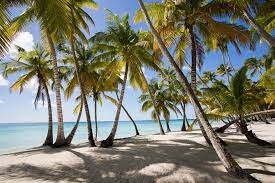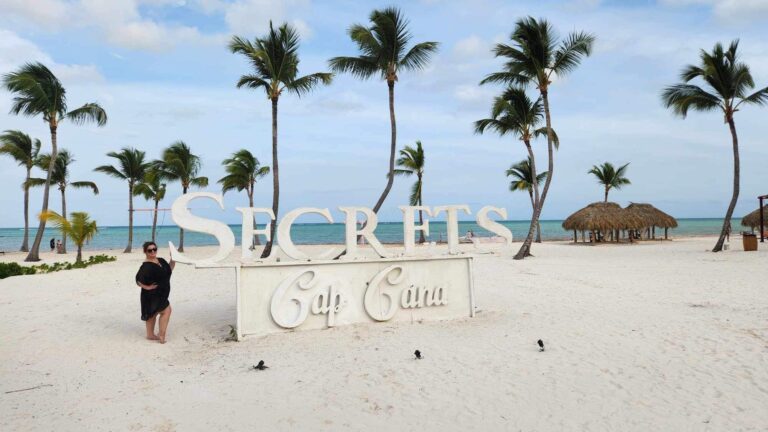
Travelers familiar with the Lilliputian scale of the Caribbean's Leeward Islands may be surprised by the Dominican Republic's size. This is not just another tiny Caribbean island with a beach and a straw market.
Instead, it's a big country with spectacularly varied scenery that includes the tallest mountains (with elevations of more than 10,000 ft/3,048 m) and lowest point (more than 100 ft/31 m below sea level) in the region; ecosystems that range from desert to cloud forest; stretches of talcum-white sand that run unbroken for miles/kilometers; and the Caribbean's oldest and—some claim—most cosmopolitan city, Santo Domingo.
No surprise, then, that the "DR," as it is colloquially known, outstrips all other Caribbean destinations in the number of international visitors by a wide margin.
The Dominican Republic was long one of the Caribbean's more obscure destinations. In the 1970s, a group of investors developed Punta Cana as a beach resort destination unrivaled by any other. Then the Dominican Republic's government began proudly splashing its assets around the world in colorful TV and print advertisements in a determination to elevate the country's name on the list of Caribbean vacation spots.
Evidence of its success is visible throughout the country. Visitor numbers, which top 5 million annually, have soared along with the construction of dozens of world-class, all-inclusive resorts. There's also been an increase in visits by cruise ships to the ports of Santo Domingo, Puerto Plata, Samana and La Romana.
Other improvements can be traced to the pursuit of tourism income: Many of the country's roads have been widened and paved, historic areas in the major cities have been renovated, Santo Domingo has gained an underground metro system, and the nation has gained a new cache among the world's rich and famous as more and more deluxe boutique-hotels, chic resorts, championship golf courses and marinas open.
Although the growth in tourism has eased some of the country's economic troubles, it hasn't ended the desperate conditions experienced by many Dominicans. The unemployment rate is high, and more than a quarter of the people live in poverty—many residing in shantytowns and rural shacks that even visitors to all-inclusive resorts will find hard to ignore.
Geography
At 250 mi/400 km by 150 mi/240 km, the Dominican Republic is larger than any other Caribbean nation except Cuba. It is also the most diverse territory in the region. The Dominican Republic boasts both the highest point in the Caribbean (Pico Duarte at 10,164 ft/3,089 m) and its lowest (Lago Enriquillo at 144 ft/44 m below sea level).
Cacti stud the desert-dry southwest in the lee of mountains clad in cloud forest. The lush agricultural valley of El Cibao lies within a one-hour drive of north coast beaches that abut mangrove-lined lagoons sheltering manatees. The bathtub-warm waters of Samana Bay attract thousands of humpback whales in winter, while nearby Los Haitises National Park is a rugged karst terrain pitted with caves. Drawing the lion's share of tourists, the talcum sands of Punta Cana and neighboring beaches shelve into waters of Maxfield Parrish hues stretching almost to the horizon.
History
The Dominican Republic was originally inhabited by the Taino people. Their peaceful way of life changed in December 1492, when Christopher Columbus came upon the island of Hispaniola (which is now divided between the Dominican Republic and Haiti). On Columbus' second voyage, in 1493, he established La Isabela, the first Spanish colony in the Americas, near today's Luperon on the north shore. His brother Bartholomew stayed to govern and later moved the capital to what is now Santo Domingo on the south coast.
As the early headquarters of the Spanish Empire in the New World, Santo Domingo flourished. It was the first city in New Spain to build a cathedral and found a university—just two of its many "firsts." Meanwhile, within a few decades of Columbus' arrival, most of the Taino were dead—wiped out by musket, sword and disease.
Spain's influence began to wane in the late 1600s as neighboring Cuba gained prominence, and the Spanish ceded the western part of the island—Haiti—to France. The Spanish, French, British and Haitians continued to battle for control of eastern Hispaniola until 1844, when Juan Pablo Duarte led the movement to establish the Dominican Republic as an independent nation.
The early decades of independence were marked by constant civil wars between competing caudillos (wealthy, power-hungry leaders) and several Haitian invasions. The government remained in turmoil well into the 1900s, with the U.S. intervening on several occasions. At one point, an annexation agreement was drawn up to make the Dominican Republic part of the U.S. It was ratified by the Dominican Senate but defeated by the U.S. Senate in 1870.
Gen. Rafael Trujillo seized power in 1930. He established a brutal reign that continued until his assassination in 1961. In the mid-1960s, Joaquin Balaguer (a corrupt Trujillo protege) took over as president, serving seven terms (with brief interruptions) until the mid-1990s. His opponents often alleged that his electoral victories were fraudulent, and some consider the 1996 election the country's first fair election.
Recent decades have been marked by a surge in tourism, heavily focused on Punta Cana, where every year sees the opening of at least one or two new megaresorts. Meanwhile, Santo Domingo—second in size only to Havana, Cuba, within the Caribbean—has evolved into a sophisticated metropolis.
Despite extreme poverty throughout the island, the nation has a robust economy. Agriculture continues to be the economic mainstay and sugar is the most important export, but the republic's tobacco industry is also important. The growing tourism revenues, however, have been most important.
After the election of Leonel Fernandez in 1996, the country made major advances and began working to overcome corruption scandals involving high-profile Dominican military leaders and drug-trafficking controversies. The current president, Luis Abinader, was elected in 2020.
Snapshot
The Dominican Republic's foremost attractions are its beautiful beaches and warm tropical waters, historical sites, casinos, golf courses, mountain scenery, national parks, merengue dancing, baseball games, cigars, reef and wreck diving, windsurfing and kiteboarding, and caves full of pre-Columbian art.
Travelers who are interested in resort activities (watersports, golf, tennis), colonial history and Caribbean culture will be happy in the Dominican Republic. Those who would rather not witness conditions in a poor, developing country or who can't tolerate reckless drivers may prefer the Virgin Islands or other smaller Caribbean resort destinations.
Potpourri
Where are the remains of Christopher Columbus? It's a matter of debate—either in Santo Domingo or in Seville, Spain. The confusion started in the late 1700s when some bones believed to be the admiral's were sent from Hispaniola to Cuba, then on to Seville. Another skeleton labeled "Cristobal Colon" was later found in Santo Domingo, however, and many experts believe that it's the authentic one. It now resides in the Columbus Lighthouse in the capital. The Dominican Republic government refuses to allow the remains in Santo Domingo to undergo DNA testing.
Lago Enriquillo is the only saltwater lake in the world with resident crocodiles.
Many consider Dominican Republic cigars to be the best in the world, surpassing in quality even those of Cuba, from whose seeds they derive.
The Dominican Republic outranks all other countries in the Caribbean and Central America for producing major-league baseball players, including superstars such as David Ortiz, Sammy Sosa and Pedro Martinez. Many honed their skills in poverty-stricken sugarcane communities around San Pedro de Macoris and La Romana.
Frequent blackouts, sometimes lasting up to 14 hours or more, continue to plague the Dominican Republic. The government even announces them in advance on the radio—sometimes. Many blackouts—apagones—are caused when the immensely powerful floodlights are switched on for special celebrations at the Faro de Colon. Many hotels and restaurants maintain their own generators.
The Taino Indians, who occupied the island before Columbus arrived, believed that their ancestors were spirits that inhabited caverns. Caves were considered sacred places, and the Taino carved zemis—effigies of spirits—to guard the entrances.
Three upper-class sisters—Patria, Minerva and Maria Mirabal—were leaders of the movement to overthrow Trujillo. They were tortured and eventually murdered by Trujillo's secret police and are today honored as national heroes known as Las Mariposas (the butterflies).







































